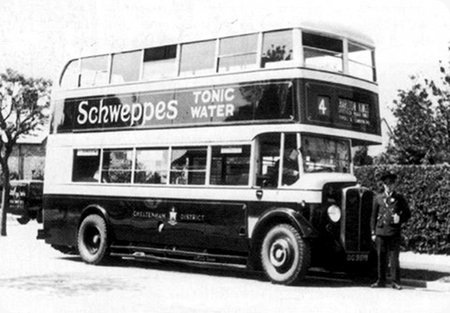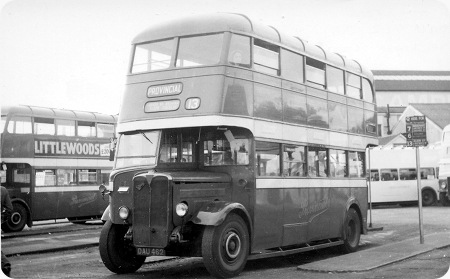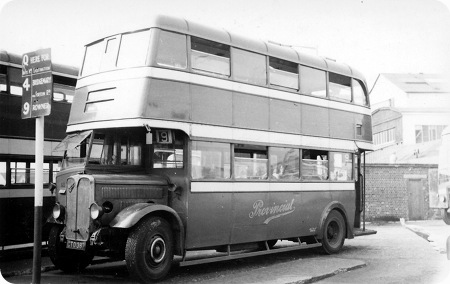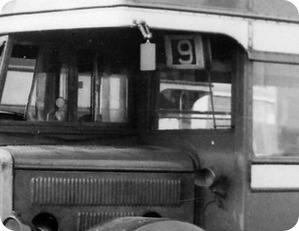Cheltenham District – AEC Regent I – DG 9819 – 2
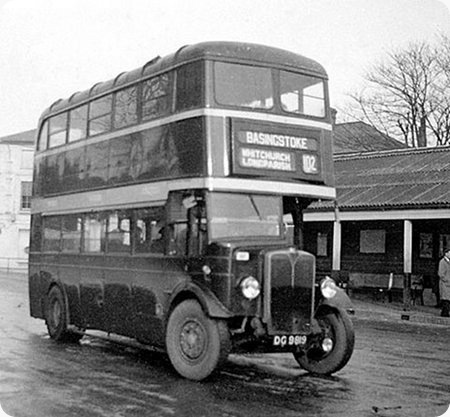
Copyright Davis Simpson Collection
Cheltenham District
1934
AEC Regent I
Weymann H30/24R
When my photos of the Cheltenham & District Albion Venturer
CX19 No. 72, were published they attracted a comment from Ian Thompson which read as follows-
"Three of the civilised and handsome Weymann-bodied 56-seat AEC Regents, mentioned by Chris, went in 1947 to fellow Red & White company Venture of Basingstoke, passing in 1951 to Wilts & Dorset. They were DG 9819 (No. 2) and DG 9820 (No. 3) of 1934, and BAD 30 (No. 10) of 1936. I remember seeing them (and secretly clambering aboard them in the AWRE Aldermaston bus park in 1955-56)."
Above are two photos of No.2, firstly looking immaculate with Cheltenham & District on 23rd May 1939 and then, about 1952, as ex-Venture 91, looking a little careworn on a filthy day, after Wilts & Dorset had taken over Venture.
Photograph and Copy contributed by Chris Hebbron
This later-life picture of DG 9818 brings back not only happy memories of AWRE Aldermaston bus park in the 50s, but also a question that has niggled me for years.
I was never content with bus-spotting from outside and was always curious about staircases and upstairs seating layout. I very distinctly recall a decker whose staircase started in the usual way–three or four steps rising towards the offside rear corner–but then instead of turning to rise forward, it made a 180-degree turn to debouch upstairs facing the nearside. The two forward-facing seats opposite the top step were only singles. I don’t remember any incursion downstairs: the whole staircase fitted into the platform-well. My admittedly fallible memory recalls this bus as one of the Cheltenham trio, but when I asked a retired Cheltenham driver about it sixteen years ago he could recall no such layout; nor could Colin Martin, author of Cheltenham’s Trams and Early Buses (Tempus 2001) and other authoritative bus books.
I’ve studied hard the photos of the DGs and BADs in Colin’s books and in Venture Limited by Birmingham and Pearce (1995) and in Wilts and Dorset, by Colin Morris and Andrew Waller (Hobnob 2006) and can see nothing that suggests what I recall. The DGs had only 24 seats downstairs and the BADs 26, but they all seated 30 upstairs, so there again there’s nothing to back me up. I begin to wonder whether the bus that I recall so clearly wasn’t an ex-Cheltenham after all, but then whose was it? All the E. Yorkshire Beverley Bar buses I’ve clambered around on seem to have had conventional stairs but with Roe-type square top steps. Can anyone disentangle me? Thanks!
And thanks, Chris H, for the pictures.
Ian Thompson
10/02/11 – 10:16
These three AECs which went to Venture as nos 85, 88 and 91 all had Gardner engines on arrival at Venture. The front bulkhead downstairs had a large rectangular panel (with round corners) protruding into the lower saloon above the flywheel cover – presumably because the Gardner 6LW took up more room than the standard AEC. They sounded rather like tractors compared with the usual Venture AECs. The staircases did indeed turn through 180 degrees and the top step protruded into the lower saloon above the off-side sideways seat next to the staircase: it was rather oval-shaped and a good example of the metalworker’s art as despite the many footsteps no dents or bumps were visible. It was just large enough for a footstep. There was no danger of a passenger bumping a head as upon standing up the body was clear of the intrusion.
Michael Peacock
24/03/12 – 09:25
As a kid I remember traveling to school on these old AEC Regents. One of the features of the Weymann coachwork was access to the destination blinds on the top deck by undoing two latches thus enabling one to alter the route number. As some of the stops were shared by more than one route such action caused some concern to passengers and did not last very long as astute conductors would remove us guilty or otherwise.
Deryck
06/12/12 – 16:54
Somehow I managed to miss Michael Peacock and Deryck’s comments on the Cheltenham Regents that ended their careers with Wilts and Dorset, and have only just read them! It’s a relief to know that my recollection of the odd staircase wasn’t mistaken after all. I think this arrangement must have been a Balfour Beatty speciality, as it’s shared by the 1949 Notts and Derby BUT/Weymann H32/26R trolleybus at the West of England collection at Winkleigh, Devon, which I saw only two months ago. Given the above-average upper deck seating capacity, the nearly-180-degree staircase was obviously space-thrifty. Belated thanks to Michael and Deryck for shedding more light on these fascinating vehicles.
Ian Thompson
Quick links to the - Comments Page - Contact Page - Home Page
